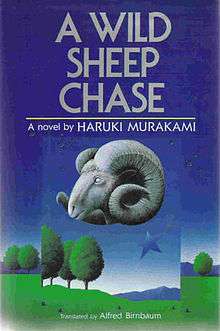A Wild Sheep Chase
 First US edition cover | |
| Author | Haruki Murakami |
|---|---|
| Original title |
Hitsuji o meguru bōken 羊をめぐる冒険 |
| Translator | Alfred Birnbaum |
| Country | Japan |
| Language | Japanese |
| Genre | Surreal novel, magical realism |
| Publisher | Kodansha International |
Publication date | October 15, 1982 |
Published in English | December 31, 1989 |
| Media type | Print (Hardcover) |
| Pages |
299 (US) 405 (JP) |
| ISBN |
0-87011-905-2 (US) ISBN 4-06-200241-8 (JP) |
| OCLC | 19670739 |
| 895.6/35 20 | |
| LC Class | PL856.U673 H5713 1989 |
| Preceded by | Pinball, 1973 |
| Followed by | Dance Dance Dance |
A Wild Sheep Chase (羊をめぐる冒険 Hitsuji o meguru bōken) (literally An Adventure Surrounding Sheep[1]) is the third novel by Japanese author Haruki Murakami. First published in Japan in 1982, it was translated into English in 1989. It is an independent sequel to Pinball, 1973, and the third book in the so-called "Trilogy of the Rat". It won the 1982 Noma Literary Newcomer's Prize.
In A Wild Sheep Chase, Murakami blends elements of American and English literature with Japanese contexts, exploring post-WWII Japanese cultural identity. The book is part mystery and part magical realism with a postmodern twist.
A Wild Sheep Chase has been defined as a parody or a renewal of Yukio Mishima's Natsuko no Bōken (夏子の冒険, Natsuko's Adventure).[2][3][4]
Plot summary
This quasi-detective tale follows an unnamed, chain-smoking narrator and his adventures in Tokyo and Hokkaido in 1978. The story begins when the recently divorced protagonist, an advertisement executive, publishes a photo of a pastoral scene sent to him in a confessional letter by his long lost friend, 'The Rat.' He is contacted by a mysterious man representing 'The Boss,' a central force behind Japan's political and economic elite who is now slowly dying. The Boss' secretary tells him that a strange sheep with a star shaped birthmark, pictured in the advertisement, was in some way the secret source of the Boss' power and that he has two months to find that sheep or his career and life will be ruined. The narrator and his girlfriend, who possesses magically seductive and supernaturally perceptive ears, travel to the north of Japan to find that sheep and his vagabond friend. As he discovers that he is chasing an unknowable power that has been exerting its influence for decades, he encounters figures from his own past, unusual characters, and those who have encountered the sheep before.
Prequels and sequel
This is the third book in Murakami's '"The Rat" Trilogy', preceded by Hear the Wind Sing and Pinball, 1973. All three books follow the sometimes surreal adventures of an unnamed first-person narrator and his friend, nicknamed 'The Rat'.
All three novels begin from or refer back to November 25, 1970, the day on which Japanese author, poet, playwright and right-wing activist Yukio Mishima committed seppuku following a failed coup attempt at the headquarters of Japan's Self Defense Forces. Some Japanese critics have speculated that A Wild Sheep Chase is a rewriting or parody of Mishima's The Adventure of Natsuko.
The sequel, Dance, Dance, Dance, continues the adventures of the unnamed protagonist. Locations and characters from A Wild Sheep Chase recur, most notably the Dolphin Hotel, the narrator's unnamed girlfriend, and the mysterious Sheep Man. However, its plot, tone and the majority of the characters are sufficiently different that Dance Dance Dance can be seen as separate from the "Trilogy of the Rat."
Awards
Book information
A Wild Sheep Chase (English edition) by Haruki Murakami; translated by Alfred Birnbaum.
- Hardcover – ISBN 0-87011-905-2, published in October, 1989 by Kodansha International
- Paperback – ISBN 0-452-26516-9, published on November 1, 1990 by Plume Fiction
- Paperback – ISBN 0-375-71894-X, published in 2002 by Vintage International
References
- ↑ Slocombe, Will https://docs.lib.purdue.edu/cgi/viewcontent.cgi?article=1232&context=clcweb
- ↑ Sato, Mikio (2006). 村上春樹の隣には三島由紀夫がいつもいる [The neighbor of Haruki Murakami always being Yukio Mishima] (in Japanese). PHP Institute.
- ↑ Takasawa, Shuji (2007). 吉本隆明 1945-2007 [Takaaki Yoshimoto 1945-2007] (in Japanese). INSCRIPT.
- ↑ Osawa, Masachi (2008). 不可能性の時代 [The times of Impossible] (in Japanese). Iwanami Shoten, Publishers.
